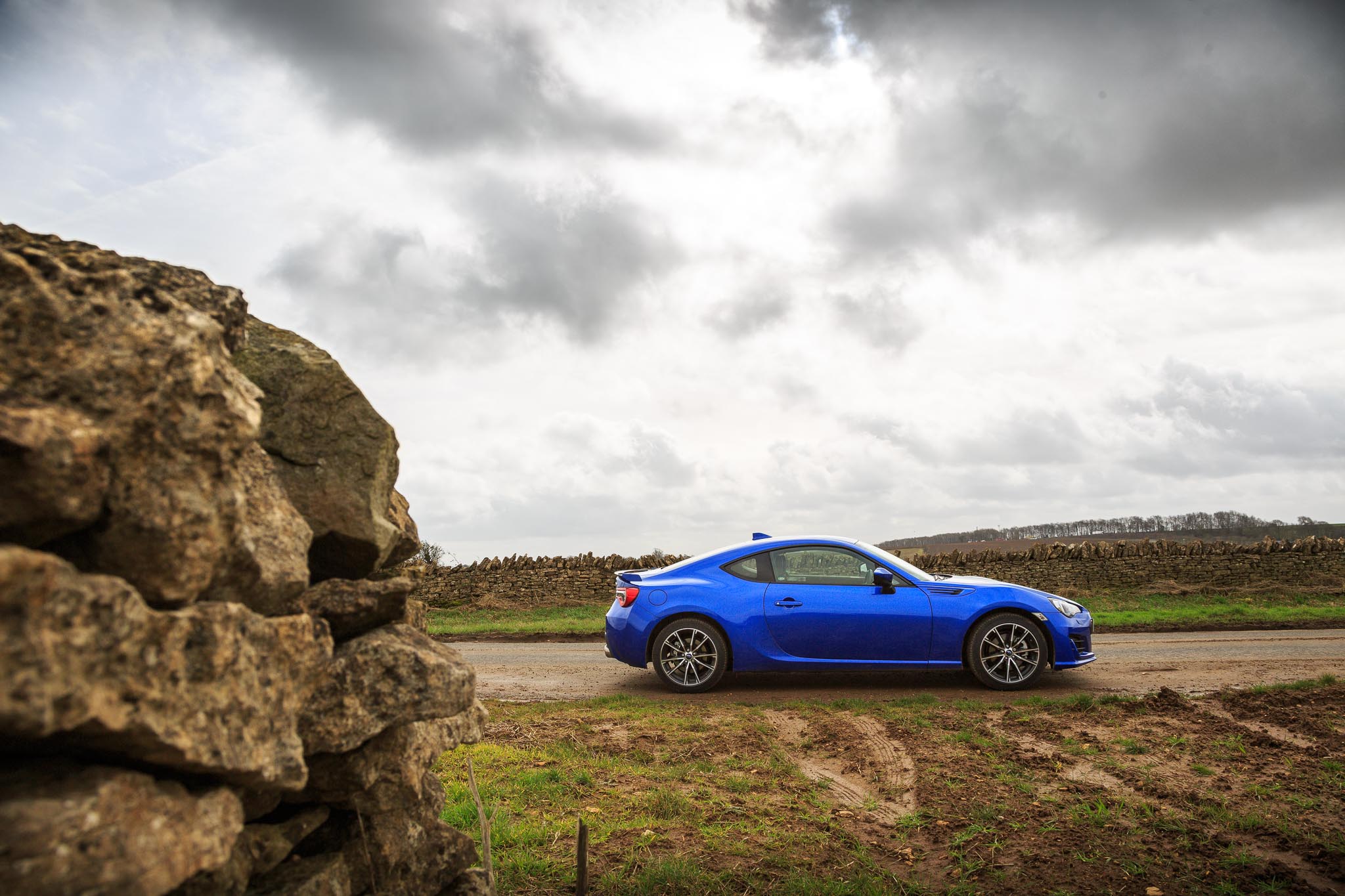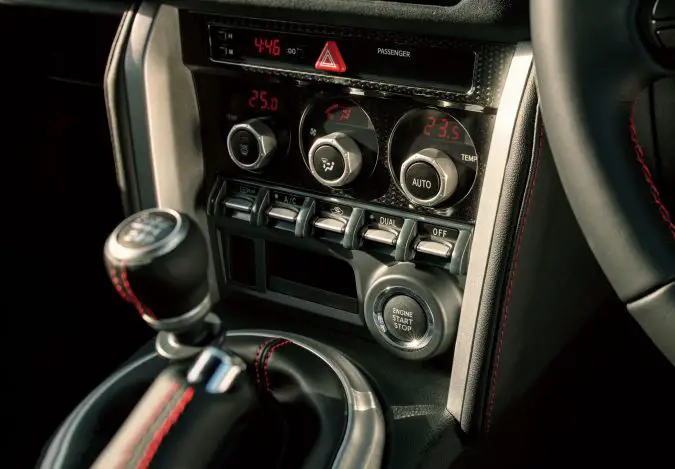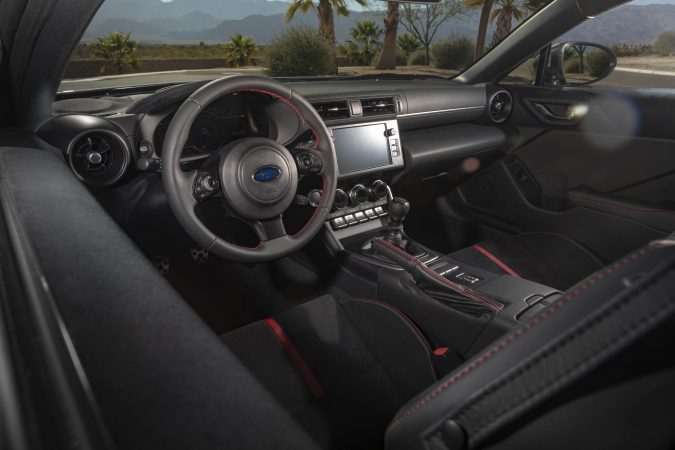In your opinion, what’s the single most important enthusiast car to launch in the past decade or two? My answer would definitely be the GT86/FR-S/BRZ, hence why we’re taking a peek at the differences between BRZ vs FR-S.
It’s easy to see why, just take a walk around and see what’s the most common 2-door sports car you can find. Depending on where you live, the GT86 or FR-S is definitely up there, with the BRZ trailing behind.
Other than that, the marketing and sales approach of these models are also unique. It’s one of the most well-known joint ventures in the automotive world, and also one of the most successful in recent years.
Despite Toyota essentially selling 3 identical models, they’ve managed to make adequate sales for all three variants. In fact, with affordable sports cars being an increasingly niche segment, it’s a success.
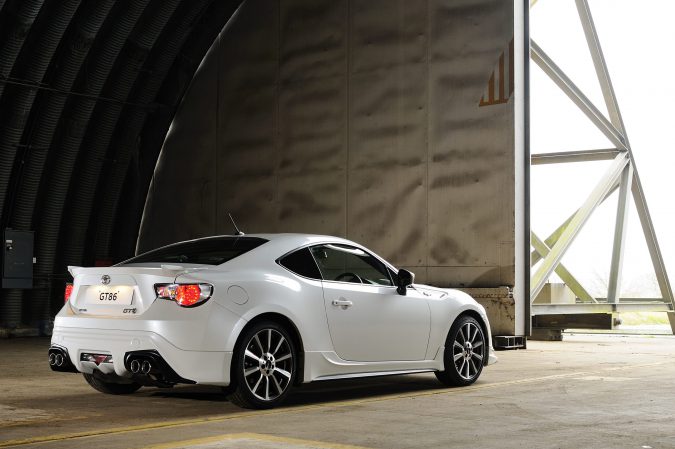
It’s one of the few 2-door sports cars that can actually breach the MX-5’s level of sales success. Certainly, as the first generation has aged, it gradually lost momentum until its eventual demise in 2020.
However, with the release of the second generation GR 86, interest has again surged. For good reason too, the new GR 86/BRZ has changed enough things around that they might be quite a gem.
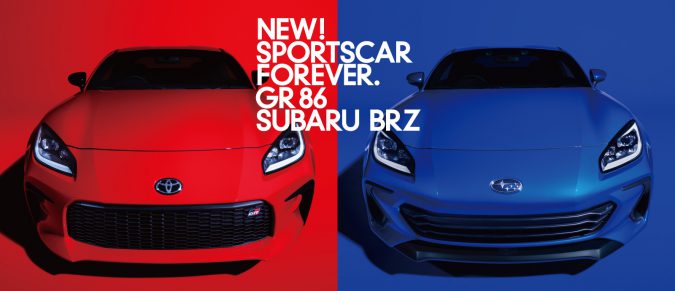
As of late, we’re beginning to see manufacturers returning to the two-door sports coupe formula with a manual transmission (to find out more, check out our explainer on what’s inside of a manual transmission). The GR 86 might just be one of the most exciting sports cars to launch for the average car enthusiast.
With that said, it’s still a joint venture project between Toyota and Subaru. Therefore, the most glaring question for most people would be ‘what’s the difference?’ What separates the BRZ vs FR-S?
Scion FR-S
First of all, for those that are unaware, the FR-S name has long been dead. In fact, Scion as a marque hasn’t existed since February 2016.
Obviously, most people living in the US would know that, but outside of the US, the Scion brand carries very little relevance.
It makes sense of course, as Scion is a make devised by Toyota to appeal to a younger market. Toyota primarily intended for compact and sporty Toyota models sold in the US to be marketed under the Scion badge.
Initially, Scion was markedly successful. It helped Toyota in shedding its boring reliable car image without detracting from Toyota’s core values.
Scion sold models straightforwardly with its “Pure Price” strategy and offered models with only one trim level. Customers would then add on customization options afterward.
We know that this didn’t pan out in the end. Underperforming sales meant that Toyota found little reason for Scion to exist. Most of its models were growing outdated, anyway.
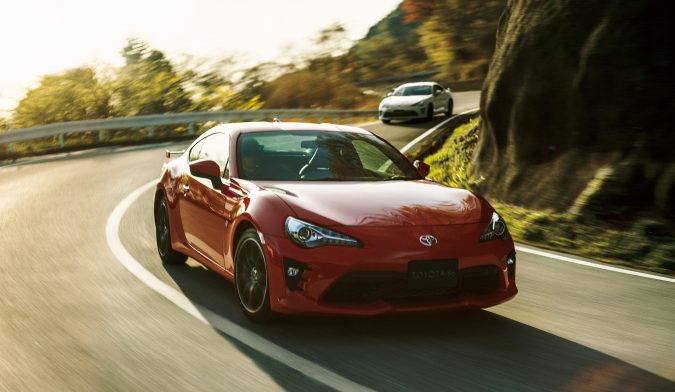
In 2016, Toyota dropped most of Scion’s models. The few that remained merged with Toyota in the US and continued selling that way. The Scion FR-S became the Toyota 86.
Therefore, the FR-S now more accurately represents the first-generation models of the GT86. There is no second-generation FR-S model.
F-RS vs BRZ vs 86
Fundamentally, all three models are the same car. It doesn’t matter whether if you bought the FR-S, BRZ, or the GT86. Underneath the body, they tout the same drivetrain and chassis.
It makes sense since the GT86 is a joint venture between Toyota and Subaru. Toyota, being a major stakeholder in Subaru, basically invited Subaru to co-develop a new mainstream sports car.
Intriguingly, Subaru declined initially but changed its mind after testing the prototype. This led to Subaru’s heavy involvement in the project resulting in the FT-86, which resembles the GT86 as we know it today.
The main appeal of the GT86 is eminent. It’s a front-engine rear-wheel-drive sports car that’s available with a 6-speed manual. And it’s built by Japanese automakers known for reliability.
BRZ VS FR-S – Similarities
Being born from the same DNA means that the FR-S and BRZ share a lot in common. It makes sense for Toyota and Subaru of course, as it allows for both models to be produced at the same production plant, saving on production costs.
All variants of the GT86, FR-S and BRZ are actually produced by Subaru at its Gunma main plant. Therefore, it’s safe to assume that the major assemblies remain identical across all three models.
1. Engine
The headline for a sports car always starts with its engine. The FR-S and BRZ are both powered by an engine mainly designed, developed, and manufactured by Subaru.
Its name depends on which model you bought. For Scion and Toyota models, this engine is known as the 4U-GSE. Unsurprisingly, it’s the only engine in its family and only found in the FR-S/GT86.
In the BRZ it’s known as the FA20D. Subaru enthusiasts will recognize this as Subaru has integrated this engine into its main lineup. The FA family is derived from the FB engines but designed to be as lightweight as possible.
Either way, it’s a 2.0-liter naturally aspirated Boxer-4 engine with both direct and port injection. It’s a perfectly square engine producing 197 horsepower and 205 Nm of torque.
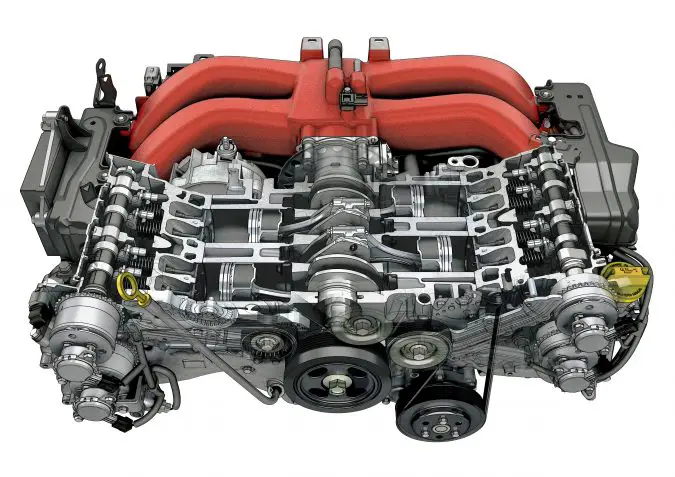
You might ponder about its fuel delivery methods. This is a result of Toyota’s D-4S injection system, melding both direct and port injection together on a single engine for the best of both worlds.
While there are certain advantages to be had with such a system, this is a simple yet intuitive method to overcome direct injection’s fatal flaw – carbon build-up. It drastically improves engine longevity.
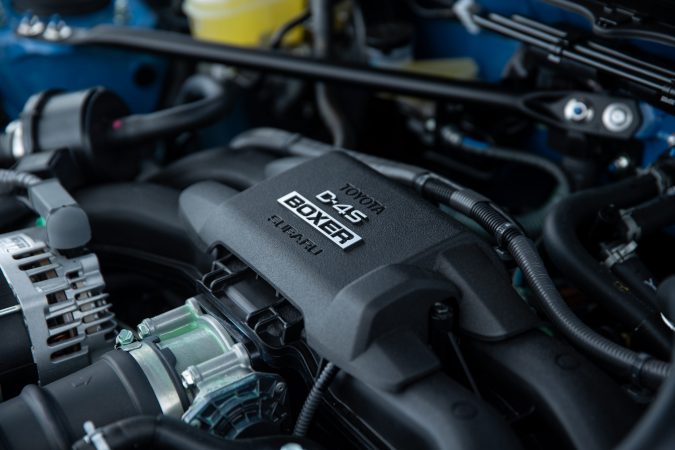
It also comes with Subaru’s own variable valve timing system – Subaru AVCS. With a combination of direct injection, quality fuel (RON 98), and AVCS, the FA20D is a surprisingly capable engine considering the omission of any forced induction.
In the facelift models, the engine had a minor power increase to 204 horsepower and 214 Nm of torque.
2. Transmission
The FR-S, BRZ, and GT86 are all offered with two transmissions available: a 6-speed automatic and a 6-speed manual. Both are transmissions from Aisin.
Notably, the manual transmission being used here is the Aisin AZ6. This is a well-known transmission and a splendid choice. It’s used in the Toyota Altezza/Lexus IS200, Honda S2000, Mazda MX-5, Nissan Silvia, and the Mazda RX-8.
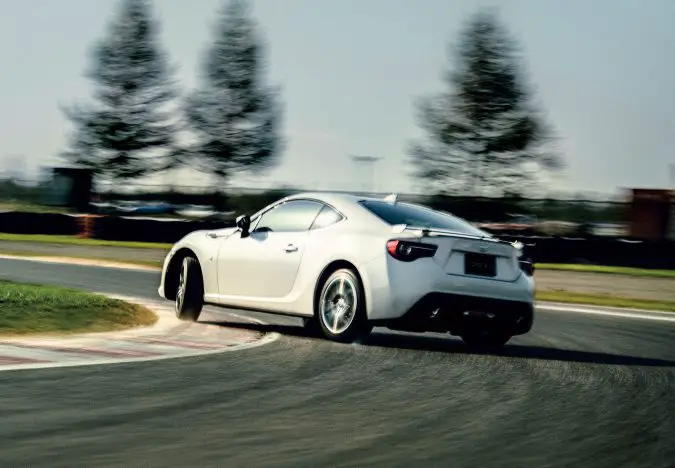
Of course, the core design is Aisin but Toyota heavily revised it for the GT86. Regardless, it’s a solid rear-drive transmission with a triple-cone synchronizer and pleasing shift action.
The automatic transmission isn’t all bad either. It’s the 6-speed automatic used in the second-generation Lexus IS, the Toyota A960E (also from Aisin).
However, Toyota upgraded the automatic transmission to reflect a sportier driving feel. This includes an earlier torque converter lockup, quicker up and downshifts as well as rev-matched downshifts.
As far as automatic transmissions go, Toyota is one of the best at it. It shifts surprisingly quickly for being over a decade old. Toyota wanted to emulate the response of a DCT, and I’d say it’s done a good job of capturing the feel.
With that said, the manual transmission is still quicker and faster than the automatic. The manual FR-S, GT86, and BRZ will go from 0 to 62 mph in 7.6 seconds, onto a top speed of 140 mph.
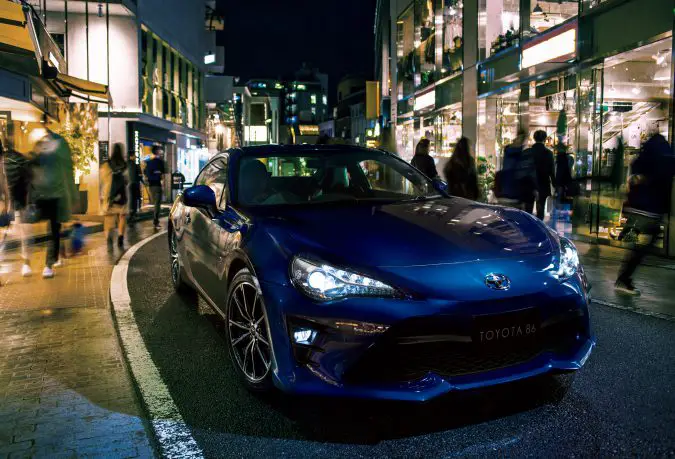
The automatic, on the other hand, goes from 0 to 62 mph in 8.2 seconds, onto a top speed of 130 mph. The automatic is also less fuel-efficient, predictably.
This is due to the much longer gear ratio in the automatic transmission. For top speed, it’s due to the electronic limiter. Hence the lower top speed despite having longer gear ratios. The final drive at 4.1 is identical across both transmissions.
Facelift models bring a shorter 4.3 final drive, which most people remark is a noticeable change and improves how the car drive and behaves drastically.
BRZ VS FR-S – Differences
Toyota/Scion and Subaru couldn’t just make and sell the same car, that’d be pretty pointless. There are some minor differences between the FR-S and the BRZ.
With that said, it might be minor, but it’s definitely enough to appeal to buyers to stick with a camp. Some even clamor, citing major differences between Toyota and Subaru models.
BRZ VS FR-S #1: Styling
It’s not immediately obvious when you’re looking at the FR-S and BRZ alone, but if you put them together, the differences in aesthetics are immediately obvious.
Subaru BRZ
The ethos behind the design and development of the BRZ emphasizes sportiness more than its counterpart. Though you do have to look quite closely to notice it.
Take the front bumper for example. It boasts a wider, “smiling-look” main grille and fog lamp grilles with hexagonal (honeycomb) designs. The headlamp design also differs slightly, the BRZ’s looks sleeker.
Post-facelift, Subaru dials it up a bit more drawing out a front splitter look. I reckon that the Boxer-style boomerang LEDs surrounding the main light are a nice touch, it makes the BRZ look meaner and more upmarket.
Also worth noting is that the BRZ comes with HID projectors from the factory, and most people agree that it’s a way better headlamp when compared to the FR-S. On the side, the BRZ features a prominent fake fender vent.
Scion FR-S
At the front, the Scion looks palpably more aggressive. It looks more like the original FT-HS concept. Some people like the angrier grunting style of the main grille design as well as the sharper fog lamp covers.
The headlamp design is sharper too. On the side, you’ll find a much smaller fender vent with an ’86’ badge featuring a Boxer-engine design.
Compared to the BRZ which has a rather minor facelift design change, the FR-S (more accurately the GT86) is significantly different. The grunt on the grille remains, but it’s broadened to look even more aggressive.
Personally, I prefer the post-facelift design of the GT86. It does a decent job and changing it up and making it look more premium and muscular without it being too busy.
Other Than That
You’d be hard-pressed to find any differences outside of the ones I’ve mentioned. The wheels are the same design too unless you specify it to be otherwise (such as the Performance Pack).
The body lines are largely indistinguishable, right down to the aft. In fact, if you debadged your FR-S or BRZ, there’d be no way to tell one or the other. Although the exhaust tips differ slightly between the two models.
BRZ VS FR-S #2: Interior
Move inside, and you’ll find more differences between the FR-S and BRZ. The FR-S persists in its theme of being sporty and aggressive, while the BRZ is more reserved and elegant.
Subaru BRZ
Step inside, and you’ll notice that the BRZ is largely monotone, bar the red stitching found throughout the interior. Subaru embroidered its own nameplate on the carpet as well.
The seats in the BRZ feature a very similar material choice to the WRX, felt material on the shoulders, and a mesh cloth on the backrest. It’s a simple seat design with a good shoulder bolster. A similar design is found on the back seats too.
You’ll also notice that the BRZ has a simple steering wheel with a plain amber-black instrument cluster dial. Subaru adorned the dash with plain silver trim but went for a padded leather design in the facelift version.
From the factory, the BRZ comes with an aftermarket-looking head unit with navigation built-in. This is available even in the base trim. The facelift BRZ comes with a new head unit that boasts Android Auto and Apple CarPlay capabilities.
Scion FR-S
Compared to the BRZ, the FR-S has more color inside. The carpet is also different too, as the FR-S has the ‘FR-S’ plaque instead of the plain embroidery.
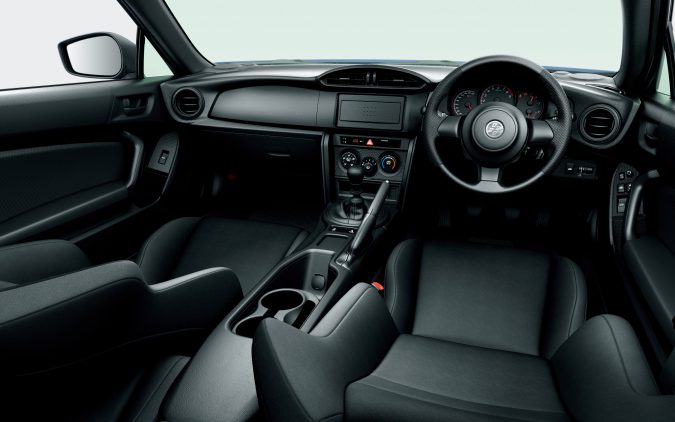
The seat material is different in the FR-S, it uses the felt material liberally at the front and back seats. Some prefer the materials used in the Subaru’s seats though. You’ll also notice the red on the seat shoulders and a vinyl seatback.
Then there are the small details, such as the fake stitching on the steering wheel and the bright white dial with a sharp numerical font. White dials definitely contribute to an upmarket, sporty feel.
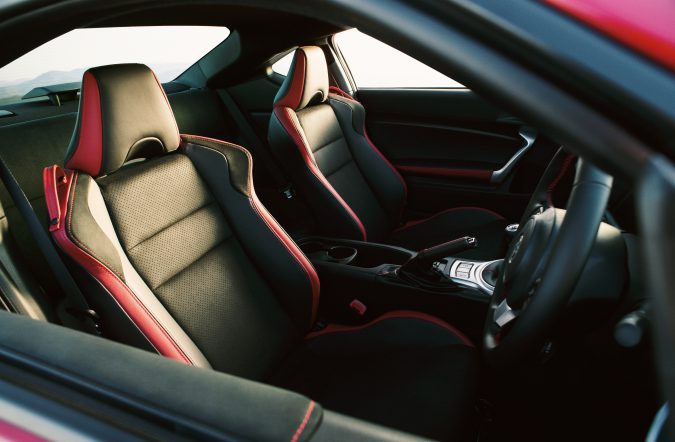
You’ll also notice the faux-carbon design dotted all over the interior, from the dash panel to the instrument cluster. The FR-S came with a much simpler Scion-branded Pioneer radio without navigation.
Thankfully, the facelift GT86 model ditches this basic head unit for a nicer touch display with navigation and Apple CarPlay/Android Auto connectivity.
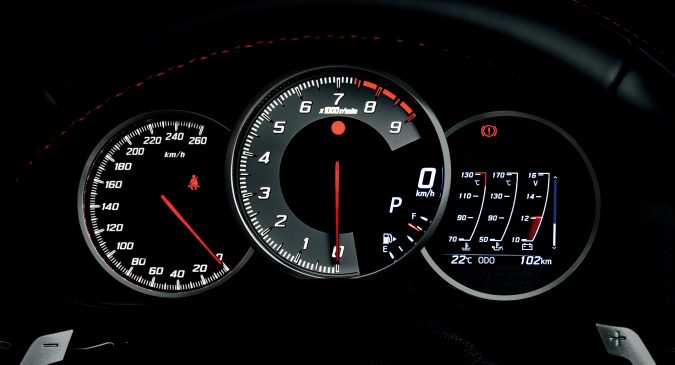
Furthermore, the facelift model ditches the faux-carbon look in favor of more Alcantara. You can even spec one with Alcantara seats.
One Caveat
Other than what I’ve mentioned, both cars aren’t exactly known for their polished, European-rivalling interior design. In fact, the age is plain to see by the end of the first-generation models.
The special edition models do attempt to spice up the interior though, mainly through the use of more exotic materials and vivid colors.
BRZ VS FR-S #3: Chassis Dynamics
Initially, the BRZ and FR-S were actually set up differently from the factory. It’s an effort to differentiate them and perhaps appeal to different owners.
Subaru BRZ
From the factory, the Subaru BRZ was set up with a 27 N/mm front spring rate and 34 N/mm rear spring rate. That’s why the BRZ was known for its more balanced ride with a decent compromise between comfort and handling.
It contributes to the understeering tendency of the BRZ. However, the stiffer front improves the responsiveness of the nose and improves the steering feel. Over bumps, people think that it rides firm, but well-supported.
Scion FR-S
Compared to the BRZ, the FR-S comes with a 23 N/mm front spring rate and a 37 N/mm rear spring rate. This is an attempt to induce a tail-happy attitude from the FR-S.
Paired with the modest tire setup and an eager throttle, it’s easier to coax the FR-S into oversteering. That said, people think that the soft front and harsh rear can cause a jarring ride over poor roads.
Everything Else
Other than the spring rate, everything else is the same, or very similar. This includes the shock damping and the sway bar cross-section (18mm front 14mm rear).
And if you buy the facelift model, there’s absolutely no difference between the GT86 and BRZ. Toyota and Subaru just agreed upon one spring rate. Reportedly, they stiffened up the front and softened the rear.
Many subtle chassis changes were also introduced, along with a revised absorber setup.
BRZ VS FR-S #4: Price And Limited Runs
The price and dealership availability is the biggest factor in most people’s purchase decisions. The FR-S and BRZ are priced differently and not everyone has access to the respective dealerships nearby.
Subaru BRZ
It’s not that relevant nowadays, but the BRZ used to start at $26,265. The base model was the BRZ Premium, but it did come with a few amenities that the base FR-S did not have.
However, the price point is moot if the buyer intended to spec up the FR-S after the purchase. What mattered was the special edition models and optional extras.
For the BRZ, the best model you could buy was probably the BRZ tS. These BRZs were further worked on by STI. It came with 18″ STI wheels with Michelin PS4s, Sachs dampers, and Brembo brakes.
There are also chassis reinforcements, such as the strut brace and front cross-member brace. It even received a big rear wing, as per STI tradition.
You’ll also notice a lot of STI Cherry Blossom Red accents throughout the car, along with Alcantara seats. This is the BRZ to buy if you’re looking for the best rendition. Three color options were available.
Scion FR-S
The Scion FR-S was priced lower at approximately $25,000. Over the years though the price got bumped up incrementally.
Scion adopted the ‘Pure Price’ strategy, where only one trim was available with very few optional extras such as the automatic transmission.
Unfortunately, the FR-S was short-lived and didn’t really receive any particularly noteworthy limited runs other than the Release Series models.
The GT86 received a couple of noteworthy limited editions, but many were only available in Japan. One of the best models available in the US was probably the GT86 TRD Limited Edition. Models produced were painted in the ‘Raven Black’ hue.
It is essentially the BRZ tS, but TRD-focused instead. It received all the same mechanical upgrades – Sachs dampers, Brembo brakes, and 18″ wheels with Michelin PS4s. Intriguingly, it also received a ‘TRD’ vinyl sticker on the side. Toyota made 1,418 examples of the TRD editions.
GR 86 VS BRZ – Second Generation Differences
In the new GR 86 and BRZ models, Toyota and Subaru follow the same formula of following the same identity with minor disparities.
1. Styling
Again, the exterior design varies depending on the model. Both models follow the general styling cues of the previous generation.
That is, the GR 86 has a clean, aggressive grunting face while the BRZ touts a bigger grin than ever. Otherwise, you can’t really tell the two apart from other angles.
2. Powertrain
Here’s the kicker, the GR 86 and BRZ actually have slightly different engines. Powering both is the FA24D. Intriguingly, Subaru used to report the 2022 BRZ as having a 13.5:1 compression ratio but has since then changed to 12.5:1, the same as the GR 86’s.
However, the GR 86 makes 232 horsepower while the BRZ makes 228. The torque is the same at 250 Nm. Regardless, Subaru has tweaked out the infamous torque dip that was present in the FA20D. It’s still a rev-happy engine that sounds brilliant.
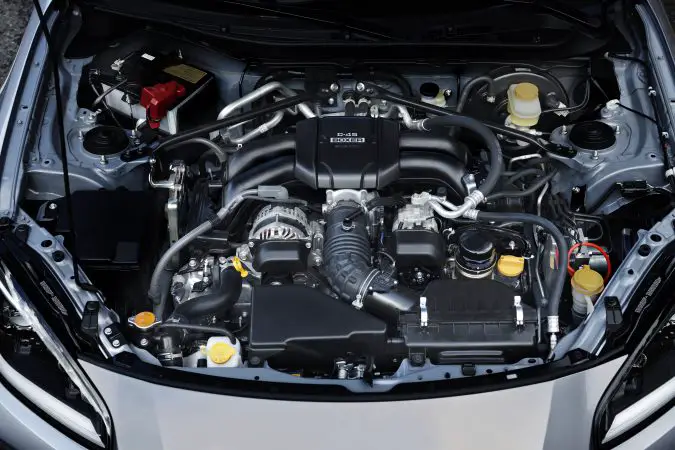
Combining that with the significantly higher low-end torque, the GR 86 and BRZ look and performs more like a sports car than ever. Crucially, it’s actually faster than the MX-5 now.
3. Chassis
Both marques follow pre-existing characteristics. The GR 86 is slightly lighter and tuned to be more tail-happy. It’s contrasted by the BRZ which is more surefooted and poised around corners.
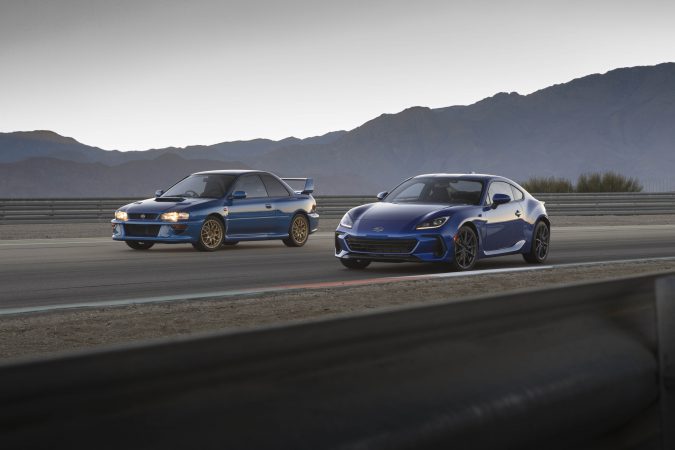
4. Interior
This time around, both the BRZ and GR 86 feature very similar-looking interiors. However, they’ve definitely stepped up their game since the first generation.
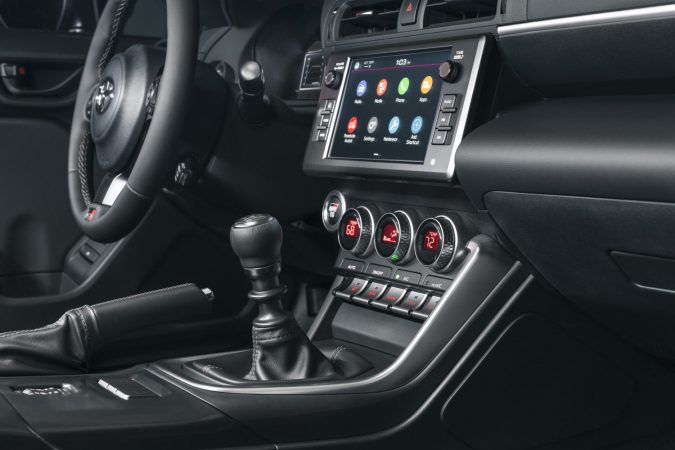
Not only does it look more modern and up-to-date, it feels that way too. Plenty of suede-esque material for that extra sporty touch paired with faux leather is always a safe choice for sports cars.
BRZ VS FR-S – Final Thoughts
The whole FR-S VS BRZ debate really comes down to personal preferences. A good rule of thumb is to stick with a post-facelift first-generation model, which introduced a lot of minor changes that ultimately culminate into a better driving car.
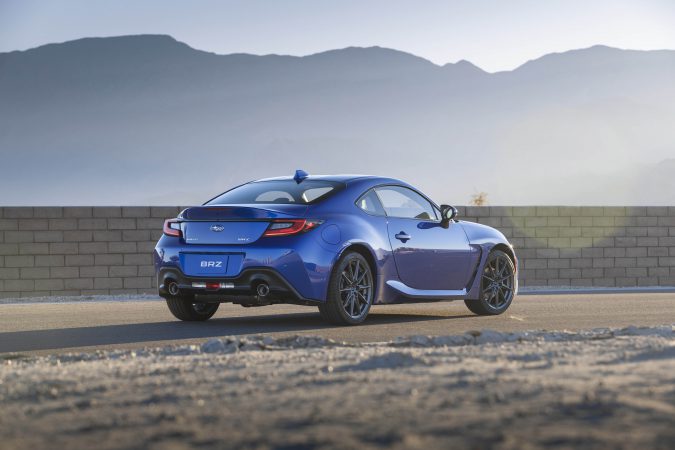
You’ll see a lot more FR-S/GT86s around than BRZs though, Toyota allocated fewer production slots for Subaru overall. Subaru also ended the production of BRZ models sooner than Toyota.
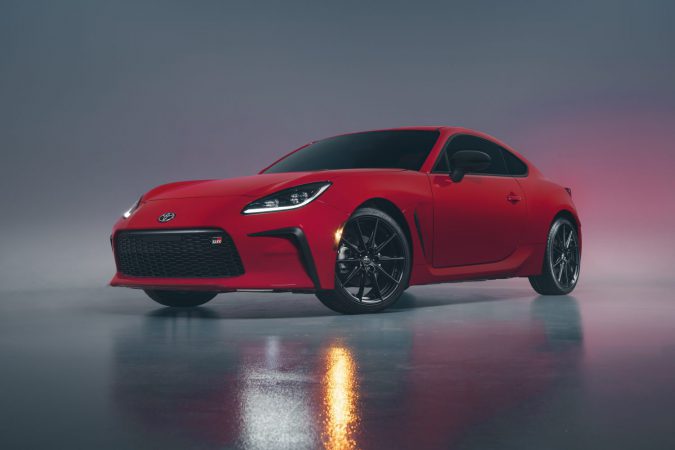
My advice is one practiced by many already, drive both and see which one you like more. And which one would you glance back at more after you’ve parked it? That’s the one you want.
It’s also worth noting that color options are limited. For example, if you like Subaru’s blue, then a BRZ with WR Blue is your only option.
FAQs On BRZ vs FR-S
If you’re curious to learn more about BRZ vs FR-S, our FAQs here might help…
What Is A Toyota 86
The GT86 is Toyota’s small, approachable, entry-level sports car, which was jointly developed with Subaru. They call theirs the BRZ, which is mostly identical to the GT86 when you’re comparing BRZ vs FR-S (the latter being Scion’s offering, which was Toyota’s affordable sub-brand in the US). Altogether, Subaru’s BRZ, Scion’s FR-S, as well as Toyota’s GT86 follow a similar approach – compact, lightweight, front-engine, and rear-wheel drive. As for the GT86 specifically, it takes its name from Toyota’s old AE86, made popular by the hit manga and anime series, Initial D. Owing to its excellent handling and fun-filled nature, the 86 is one of the most popular and beloved sports cars in today’s market.
How Much Is A Scion FR-S
Scion was launched by Toyota as its American-based sub-brand. It mainly catered towards stylish, affordable, and sporty cars, made for the younger generation. It’s not a surprise that when Toyota brought the 86 sports car nameplate back to life, it was also sold in North America as a Scion. Specifically, the Scion FR-S, which was later discontinued as they then unveiled the second-generation model, which is sold only as a Subaru BR-Z and a Toyota GT86. Back when it was new, the Scion FR-S is more barebones than either the GT86 or the BRZ. Following a more back-to-basics approach, the FR-S was also cheaper than either the Subaru or Toyota, with the base-level trim starting at under $20,000.
Is The Subaru BRZ Reliable
If you’re looking for a fun, fast, sporty, yet reliable sports car, the Subaru BRZ is one of the best options available. The same goes with the GT86 and the FR-S too, as there are very few differences between the BRZ vs FR-S or BRZ vs GT86. For the most part, the BRZ never had any serious reliability issues, and most problems that were reported were isolated to individual cases. Yet, there were still some concerns to be wary of. For example, some owners noted that their BRZ’s power steering would cut out suddenly. Plus, a few BRZ owners have also documented noisy transmissions, glitchy infotainment systems, as well as problems with Subaru’s EyeSight driver-assist systems.
How Much HP Does The Scion FR-S Have
The Scion FR-S came with a similar boxer-type engine that was fitted to its siblings, the Toyota GT86 and Subaru BRZ. Specifically, it’s a 2.0-liter 4-cylinder boxer engine, with 200hp (peak power at 7,000RPM) and 151 lb-ft of torque (peak torque at 6,600RPM). By default, it’s mated to a 6-speed manual transmission, but a 6-speed auto was offered, too. Although the lightweight nature of the FR-S meant that 200hp is enough to have fun, some still crave more. That’s why turbo kits and other aftermarket mods were very popular among FR-S owners, keen on extracting more power from that engine. In fact, a simple bolt-on turbo could easily bump that up to at least 400hp to 500hp or more.
Are Toyota 86 And Subaru BRZ The Same
For the most part, comparing either the BRZ vs 86 or BRZ vs FR-S will show that these 3 cars are practically identical to one another. The key difference between the GT86 and the BRZ is mostly design-wise. The GT86 has a much sportier front end and has a more muscular bodywork. Meanwhile, the BRZ looks much more tame in comparison. Another trick to tell apart a BRZ from an 86 is by looking inside. Subaru’s BRZ can be optioned with Alcantara, while the 86 makes do with cloth. Moreover, the infotainment screen in the 86 is bigger than the one in the BRZ. Elsewhere, the are also minute differences in trim level or individual options, and slight variations in pricing.

